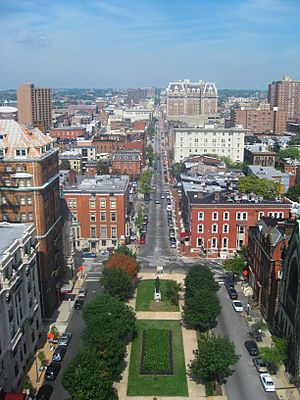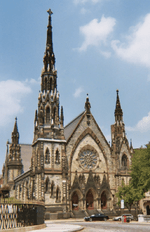Mount Vernon, Baltimore facts for kids
Quick facts for kids
Mount Vernon
Midtown
|
|||||||||||||||||||||||
|---|---|---|---|---|---|---|---|---|---|---|---|---|---|---|---|---|---|---|---|---|---|---|---|

Northward view from the Washington Monument
|
|||||||||||||||||||||||
| Country | United States | ||||||||||||||||||||||
| State | Maryland | ||||||||||||||||||||||
| City | Baltimore | ||||||||||||||||||||||
| Founded by | John Eager Howard | ||||||||||||||||||||||
| Named for | Mount Vernon Estate | ||||||||||||||||||||||
| Time zone | UTC-5 (Eastern) | ||||||||||||||||||||||
| • Summer (DST) | EDT | ||||||||||||||||||||||
| ZIP code |
21201, 21202
|
||||||||||||||||||||||
| Area code | 410, 443, and 667 | ||||||||||||||||||||||
|
|||||||||||||||||||||||
Mount Vernon is a cool neighborhood in Baltimore, Maryland. It's just north of the city's downtown area. The neighborhood gets its name from George Washington's famous Mount Vernon home in Virginia. This is because Baltimore's own Washington Monument is located right here!
Contents
Discovering Mount Vernon
The city of Baltimore describes Mount Vernon as being surrounded by certain streets. To the north, you'll find Eager Street. The Jones Falls Expressway is on the east side. Franklin Street forms the southern border. And Eutaw Street is on the west.
Right next to Mount Vernon, to the north, is the Mid-Town Belvedere neighborhood. Sometimes, people think of these two areas as one big neighborhood.
Getting around Mount Vernon is easy! The Light RailLink train runs along Howard Street. The Metro Subway runs underground, beneath Eutaw Street. If you're traveling further, Penn Station is nearby. It's a train station for Amtrak and MARC commuter trains.
Mount Vernon is mostly a place where people live. But it's also home to many important buildings and organizations. You can find the Peabody Conservatory here, which is part of Johns Hopkins University. There's also the Walters Art Museum, the University of Baltimore, and the Maryland Center for History and Culture.
Other cool places include the Maryland Institute College of Art and the Joseph Meyerhoff Symphony Hall. If you love theater, check out the Baltimore School for the Arts or Center Stage. The main branch of the Enoch Pratt Free Library is also in Mount Vernon.
Historic Buildings and Parks
The most special part of Mount Vernon is its parks. They are arranged in a cross shape around the Washington Monument. This was one of the first times a city planned its layout to show off a monument!
The Washington Monument was finished in 1829. It was designed by Robert Mills. A few years later, in 1831, the Howard family was allowed to create the parks around it. These parks are still beautiful today. They were designed by a famous architecture firm called Carrère and Hastings. They also designed parts of the U.S. Capitol building!
Around the neighborhood, you'll see many old apartment buildings. There are also lots of three and four-story rowhouses. These are houses built in a row, sharing side walls.
The Belvedere Hotel opened in 1903. It was later changed into apartments in 1991.
The Mount Vernon Place United Methodist Church is northeast of the Washington Monument. It was built where Francis Scott Key (who wrote "The Star-Spangled Banner") used to live.
The Peabody Institute takes up the entire southeast corner near the monument. The southwest corner has three buildings that are part of the Walters Art Museum.
The old Stafford Hotel was built in 1894. It's now an apartment building, and many students from the Peabody Institute live there.
Another old building is the Mount Vernon Hotel at 702 Cathedral Street. It was built in 1847 as a mansion. A U.S. Congressman named William Julian Albert lived there. He even hosted Abraham Lincoln! Later, it became a hotel in 1967.
The area around the Washington Monument is very important. It's called the Mount Vernon Place Historic District. It was added to the National Register of Historic Places in 1971. This means it's a special place that needs to be protected.
Some specific buildings and areas in the historic district are also recognized as Baltimore City Landmarks. These include:
- The Washington Monument and the parks around it.
- The Peabody Institute buildings.
- The Thomas-Jencks-Gladding House.
- The George Howard House.
The historic district also includes:
- Mount Vernon Place United Methodist Church and Asbury House.
- The Stafford Hotel.
Other important places in the Mount Vernon neighborhood are:
The entire Mount Vernon neighborhood is part of the Baltimore National Heritage Area. This area was created in 2009 to celebrate Baltimore's history and culture.
Education in Mount Vernon
Mount Vernon is a great place for students! The Baltimore School for the Arts is located on Cathedral Street. This school helps young artists develop their talents.
In 2010, a new public school for girls opened in Mount Vernon. It's called the Baltimore Leadership School for Young Women (BLSYW). It moved into an old building that used to be the Young Women's Christian Association (YWCA). This was the first new public school in the neighborhood in 30 years!
Images for kids



